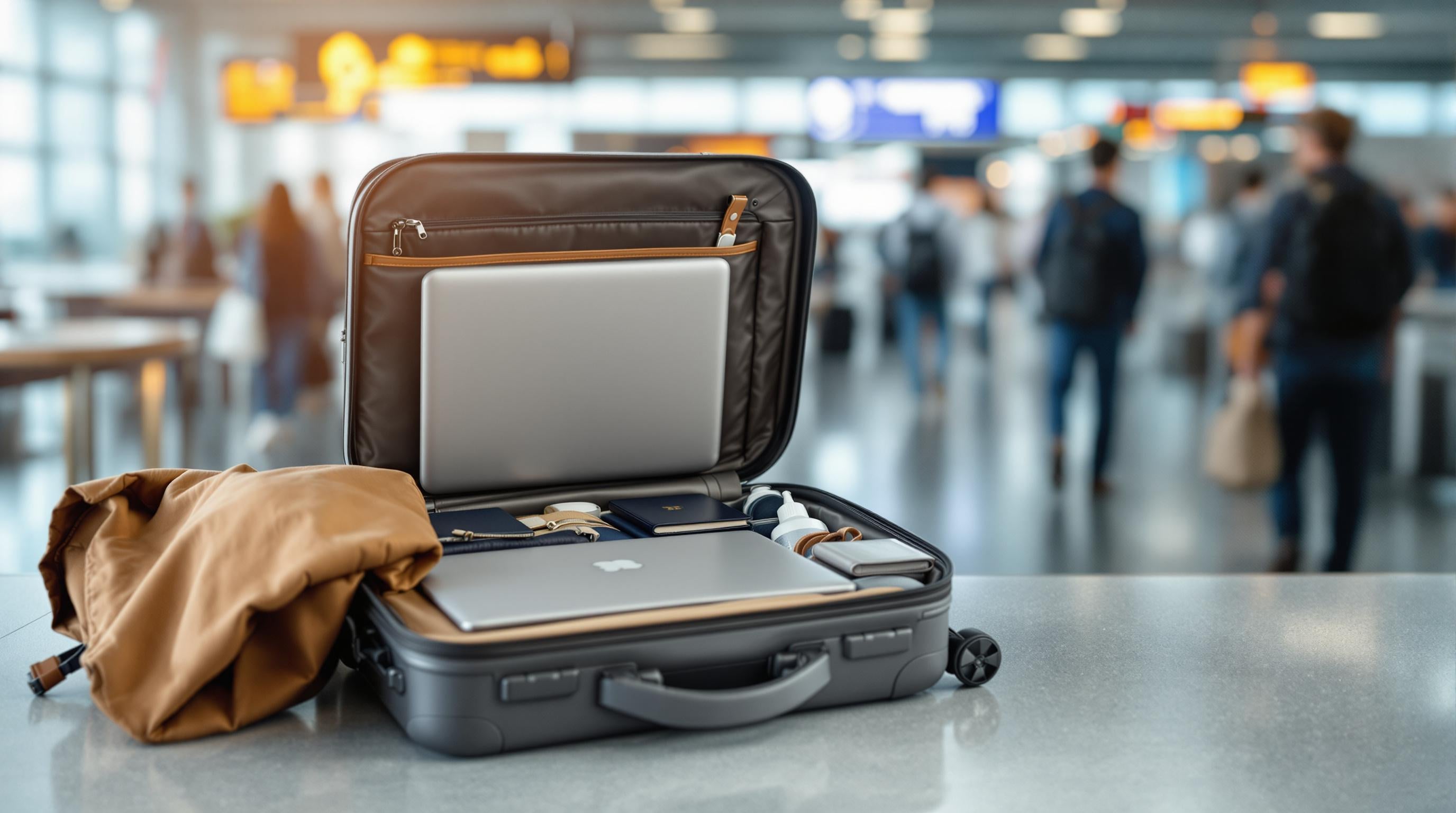Traveling with a carry-on? Here's what you need to know upfront:
- Size & Weight: U.S. airlines allow carry-ons up to 22×14×9 inches, often without weight checks. International carriers, especially budget ones, may have stricter size and weight limits (15–22 lbs). Always check your airline’s policy.
- Prohibited Items: Liquids over 3.4 oz, sharp objects, flammables, and weapons are banned globally. Some countries, like Japan or the UAE, have unique restrictions (e.g., medications, religious materials).
- Packing Tips: Use compression bags, roll clothes, and pack heavy items at the bottom. Keep electronics and liquids accessible for security checks.
Quick Tip: Double-check your airline’s rules before traveling to avoid surprises at the gate.
MUST-KNOW Carry-on and Personal Item Rules for Flying
Size and Weight Rules
Take Ryanair as an example: even compressed bags can sometimes exceed their strict limits.
Size Limits
For most U.S. airlines, carry-ons must fit within 22×14×9 inches. International airlines can differ, with budget carriers often imposing stricter size requirements.
Weight Limits
In the U.S., carry-ons are rarely weighed. However, many international airlines enforce weight limits between 15–22 pounds, either at check-in or at the gate. To avoid last-minute surprises, it’s smart to check your bag’s weight before heading to the airport.
Staying Within the Rules
- Use a portable scale to confirm your bag’s weight and dimensions after packing.
- If you’re using compression bags like Titantrek's Atlas Vault to save space, keep in mind that budget airlines might still measure the compressed size [1].
Policies can change, so always double-check your airline’s rules. Gate agents often enforce limits more strictly than check-in staff.
Banned Items List
Once you've confirmed your bag fits the size requirements, double-check its contents. Carry-on restrictions differ by region, so it's important to know what you can and can't bring. Below are general global rules, followed by country-specific regulations for added clarity.
Global Restrictions
Most airlines and security agencies around the world prohibit the following items in carry-on luggage:
- Liquids exceeding 3.4 oz (100 mL)
- Sharp objects like knives or scissors with blades longer than 4 inches
- Flammable materials
- Explosives or devices that can start fires
- Weapons and ammunition
- Toxic substances
- Compressed gases
Country-Specific Rules
While the core restrictions are similar worldwide, some countries have additional rules:
- Japan: Strict limitations on bringing certain medications.
- UAE: Prohibits carrying religious materials from other faiths.
- UK: E-cigarettes must be packed in carry-on bags.
- Australia: No powders exceeding 12 oz (350 mL).
- USA: Requires liquids to be stored in clear, resealable bags.
Quick Reference Guide
Use this checklist to ensure your carry-on meets the rules:
- Liquids in containers no larger than 3.4 oz (100 mL)
- All liquids placed in a 1-quart (1 L) clear, resealable bag
- No tools or sharp objects longer than 4 inches
- No sports equipment
- Electronics easily accessible for screening
- Medications packed with prescriptions
- No firearms, replicas, or similar items
These restrictions will impact how you pack efficiently, which we’ll explore in the next section. Keep this checklist handy for quick compliance.
sbb-itb-b1567d8
Packing Methods
Space-Saving Tips
Using a vacuum compression backpack, like the Titantrek Atlas Vault, can help reduce clothing bulk [1]. Here are some ways to make the most of your packing space:
- Roll your clothes instead of folding them to cut down on wrinkles and save room.
- Secure items with compression straps to keep everything in place.
- Store small items inside shoes or hats to maximize every inch of space.
- Place heavier items at the bottom of your bag to maintain balance.
Useful Packing Tools
The right tools can make packing more organized and help during security checks:
- Vacuum compression backpack: Great for reducing bulk and keeping your items compact.
- TSA-approved lock: Keeps your bag secure while complying with airport screening requirements.
- Packing cubes: Help organize your belongings for quick and easy inspections.
Once you're packed, arrange your carry-on to breeze through airport security with minimal hassle.
Airport Security Guide
Get through airport security smoothly by staying prepared and organized. Here's how:
Security Screening Steps
- Place laptops and tablets in a separate bin.
- Store liquids in a clear, resealable quart-sized bag.
- Remove coats, belts, and shoes for screening.
- Keep your boarding pass and ID easily accessible.
- Have chargers and other non-liquid items ready for inspection.
Final Size Check
Double-check your airline's carry-on size and weight limits using a luggage sizer. Make sure your bag meets the requirements, whether compressed or not [1].
Policy Updates
Visit your airline's website before your trip to review the latest security rules and carry-on restrictions. Policies can vary by destination and may change unexpectedly.
Summary
Carry-on rules differ depending on the airline, so it's important to check their specific size, weight, and security requirements.
- Check size restrictions: Confirm your bag fits the airline's guidelines.
- Pack smart for weight: Use lightweight packing tools and vacuum compression bags.
- Follow security rules: Avoid prohibited items and organize your bag for easy screening.
The Titantrek Atlas Vault vacuum-compression backpack is designed to simplify packing while meeting most airline carry-on standards.

How Waterproof Coatings Protect Travel Gear
Ultimate Guide to Modular Packing for Families